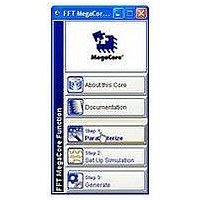IPR-FFT Altera, IPR-FFT Datasheet - Page 53

IPR-FFT
Manufacturer Part Number
IPR-FFT
Description
IP CORE Renewal Of IP-FFT
Manufacturer
Altera
Type
MegaCorer
Specifications of IPR-FFT
Software Application
IP CORE, DSP Filters And Transforms
Supported Families
Arria GX, Cyclone, HardCopy, Stratix
Features
Bit-Accurate MATLAB Models, Radix-4 And Mixed Radix-4/2 Implementations
Core Architecture
FPGA
Core Sub-architecture
Arria, Cyclone, Stratix
Rohs Compliant
NA
Function
Fast Fourier Transform Processor
License
Renewal License
Lead Free Status / RoHS Status
na
Lead Free Status / RoHS Status
na
Introduction
Block Floating Point
© December 2010 Altera Corporation
The FFT MegaCore
perform calculations. BFP architecture is a trade-off between fixed-point and full
floating-point architecture.
Unlike an FFT block that uses floating point arithmetic, a block-floating-point FFT
block does not provide an input for exponents. Internally, a complex value integer
pair is represented with a single scale factor that is typically shared among other
complex value integer pairs. After each stage of the FFT, the largest output value is
detected and the intermediate result is scaled to improve the precision. The exponent
records the number of left or right shifts used to perform the scaling. As a result, the
output magnitude relative to the input level is:
For example, if exponent = –3, the input samples are shifted right by three bits, and
hence the magnitude of the output is output*2
After every pass through a radix-2 or radix-4 engine in the FFT core, the addition and
multiplication operations cause the data bits width to grow. In other words, the total
data bits width from the FFT operation grows proportionally to the number of passes.
The number of passes of the FFT/IFFT computation depends on the logarithm of the
number of points.
corresponding bit growth.
A fixed-point architecture FFT needs a huge multiplier and memory block to
accommodate the large bit width growth to represent the high dynamic range.
Though floating-point is powerful in arithmetic operations, its power comes at the
cost of higher design complexity such as a floating-point multiplier and a floating-
point adder. BFP arithmetic combines the advantages of floating-point and fixed-
point arithmetic. BFP arithmetic offers a better signal-to-noise ratio (SNR) and
dynamic range than does floating-point and fixed-point arithmetic with the same
number of bits in the hardware implementation.
In a block-floating-point architecture FFT, the radix-2 or radix-4 computation of each
pass shares the same hardware, with the data being read from memory, passed
through the core engine, and written back to memory. Before entering the next pass,
each data sample is shifted right (an operation called "scaling") if there is a carry-out
bit from the addition and multiplication operations. The number of bits shifted is
based on the difference in bit growth between the data sample and the maximum data
sample detected in the previous stage. The maximum bit growth is recorded in the
exponent register. Each data sample now shares the same exponent value and data bit
width to go to the next core engine. The same core engine can be reused without
incurring the expense of a larger engine to accommodate the bit growth.
output*2
-exponent
Table A–1 on page A–2
®
function uses block-floating-point (BFP) arithmetic internally to
A. Block Floating Point Scaling
shows the possible exponents for
3
.
FFT MegaCore Function User Guide















